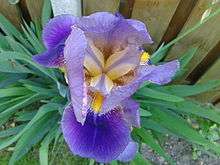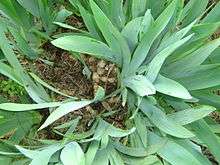Iris × germanica
Iris × germanica is the accepted name for a species of flowering plants in the family Iridaceae commonly known as the bearded iris[2] or the German bearded iris.[3] It is one of a group of hybrid origin.[4]:87 Varieties include I. × g. var. florentina.
| Iris × germanica | |
|---|---|
 | |
 | |
| Scientific classification | |
| Kingdom: | |
| (unranked): | |
| (unranked): | |
| Order: | |
| Family: | |
| Subfamily: | |
| Tribe: | |
| Genus: | |
| Subgenus: | |
| Section: | Iris |
| Species: | I. × germanica |
| Binomial name | |
| Iris × germanica | |
| Synonyms[1] | |
|
List
| |
Description
Iris × germanica grows up to 120 cm (47 in) high and 30 cm (12 in) wide.[5] The roots can go up to 10 cm (3.9 in) deep and it is a rhizomatous perennial that blooms mid to late spring. Hundreds of hybrids exist representing nearly every colour from jet black to sparkling whites, except bright scarlet.
Biochemistry
It is known to produce the isoflavone irilone,[6] and several analytical studies have been made from the rhizomes.[7]
As most irises are diploid, having two sets of chromosomes. This can be used to identify hybrids and classification of groupings.[8] It has had its chromosome counted several times; 2n=44, Banerji & Chaudhuri, 1972; 2n=28, Mao 1986; 2n=44 Sopova 1982; 2n=44, Váchová & Feráková, 1986 and 2n=44, Lovka, 1995.[9]
Taxonomy
It is most commonly known as 'bearded iris' and in the UK occasionally as 'common German flag'.[10]
It was first published and described by Carl Linnaeus in his book 'Species Plantarum' on page 38 in 1753.[1][11][12]
Iris germanica is an accepted name by the RHS,[10] and it was verified by United States Department of Agriculture Agricultural Research Service on 8 May 1996.[11]
It is a European hybrid, rather than a true wild species.[5] I. germanica is considered to have been a natural hybrid between Iris pallida and Iris variegata Linnaeus, both of which also have the chromosome number 2n = 24.[13]
Distribution and habitat
Iris germanica is thought to be originated in mediterranean Europe.[11][10]
Range
It is widely naturalized across Europe.[9]
Cultivation
It prefers to grow in full sun, with well-drained soil. It normally retains some of its leaves over the winter period. After it has flowered and during dry conditions through the summer is best time to divide and transplant.[9]
Propagation
It can be propagated by seed and by division.[13]
Hybrids and cultivars
Iris germanica has many cultivars and further hybrids. These are a few known cultivars:[9]
|
|
|
I. germanica var. amas was one of the most important cultivars in the creation of the modern tetraploid tall-bearded Irises.[9]
In culture

In Iran and Kashmir,[14] Iris kashmiriana and Iris × germanica[15] are most commonly grown on Muslim[16] grave yards.[8][17][18]
It has frequently been painted including 'Iris' (see right) and 'Irises' both by Vincent Van Gogh.[19]
Photo gallery

 Iris 'Fabian' hybridized by John Salter, 1868, UK
Iris 'Fabian' hybridized by John Salter, 1868, UK
See also
References
- "Iris × germanica L. is an accepted name". theplantlist.org (The Plant List). 23 February 2012. Retrieved 17 May 2016.
- "BSBI List of British & Irish Vascular Plants and Stoneworts".
- Rudy J. Favretti and Joy P. Favretti Landscapes and Gardens for Historic Buildings: A Handbook for Reproducing and creating authentic landscape settings, p. 145, at Google Books
- Stace, C. A. (2010). New Flora of the British Isles (Third ed.). Cambridge, U.K.: Cambridge University Press. ISBN 9780521707725.
- "Garden Bearded Irises". Pacific Bulb Society. Retrieved 25 November 2014.
- "Lipase-catalyzed regioselective protection/deprotection of hydroxyl groups of the isoflavone irilone isolated from Iris germanica". 27 (2). Cite journal requires
|journal=(help) - Shahid Akbar Handbook of 200 Medicinal Plants: A Comprehensive Review of Their Traditional Medical Uses and Scientific Justifications, p. 1047, at Google Books
- Austin, Claire (2005). Irises: A Gardener's Encyclopedia. Timber Press, Incorporated. ISBN 978-0881927306. OL 8176432M.}
- Laurin, T. (6 May 2019). "(SPEC) Iris germanica L." Retrieved 4 May 2020.
- "Iris germanica bearded iris". rhs.org.uk. Retrieved 4 May 2020.
- "Iris germanica". Germplasm Resources Information Network (GRIN). Agricultural Research Service (ARS), United States Department of Agriculture (USDA). Retrieved 4 May 2020.
- "Iris germanica L., Sp. Pl. 1: 38 (1753)". ipni.org (International Plant Names Index). Retrieved 4 May 2020.
- "FNA Vol. 26 Page 373, 375, 376,". efloras.org (Flora of North America). Retrieved 4 May 2020.
- "Chapter I Rhizomatous Iris (part 2)". irisbotanique.over-blog.com. Retrieved 20 October 2015.
- Singh, Gurcharan. "Kashmir Iris". flowersofindia.net. Retrieved 22 October 2015.
- Stebbings, Geoff (1997). The Gardener's Guide to Growing Irises. Newton Abbot: David and Charles. p. 23. ISBN 0715305395.
- British Iris Society (1997) A Guide to Species Irises: Their Identification and Cultivation, p. 38-39, at Google Books
- Trak, Touseef Hussain; Upadhayay, Ravi (April 2015). "Ethnobotanical And Taxonomic Study Of Members of Iridaceae Family of Kishtwar, (Jammu And Kashmir) India" (PDF). International Journal of Pharma and Bio Sciences. 6 (2): 779–793. Archived from the original (PDF) on 2 August 2016. Retrieved 22 October 2015.
- Jennifer Helvey Irises: Vincent Van Gogh in the Garden, p. 21, at Google Books
Sources
- Czerepanov, S. K. 1995. Vascular plants of Russia and adjacent states (the former USSR) Cambridge University Press. Note: lists as Iris germanica L.
- Davis, P. H., ed. 1965-1988. Flora of Turkey and the east Aegean islands. Note: lists as Iris germanica L.
- Encke, F. et al. 1993. Zander: Handwörterbuch der Pflanzennamen, 14. Auflage Note: = species
- FNA Editorial Committee. 1993-. Flora of North America. Note: lists as Iris germanica L.
- Komarov, V. L. et al., eds. 1934-1964. Flora SSSR. Note: = Iris germanica L.
- Lampe, K. F. & M. A. McCann. 1985. AMA handbook of poisonous and injurious plants
- Mathew, B. 1981. The Iris. 25-28.
- Nasir, E. & S. I. Ali, eds. 1970-. Flora of [West] Pakistan.
- Personal Care Products Council. INCI
- Rechinger, K. H., ed. 1963-. Flora iranica. Note: lists as Iris germanica L.
- Stace, C. 1995. New flora of the British Isles. Note: natzd.
- Townsend, C. C. & E. Guest. 1966-. Flora of Iraq. Note: = Iris germanica L.
- Tutin, T. G. et al., eds. 1964-1980. Flora europaea. Note: = Iris germanica L.*
- Waddick, J. W. & Zhao Yu-tang. 1992. Iris of China
- Walters, S. M. et al., eds. 1986-2000. European garden flora
External links

